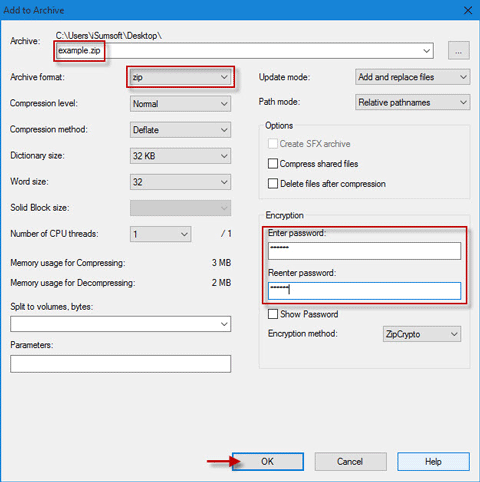
- #Mac os password protect zip file for mac os
- #Mac os password protect zip file for mac
- #Mac os password protect zip file install
- #Mac os password protect zip file archive
- #Mac os password protect zip file download
Choose any folder for all extracted files to be extracted to. The Extraction tab in SecureZIP Preferences allows you to select a new default folder, or be prompted for a destination folder each time you open an archive.

If another file with the same name is located in that same directory in Finder, the newly-extracted file is added as a copy of the original file.
#Mac os password protect zip file install
When you first install SecureZIP, newly extracted (that is, unzipped) files are placed in the same directory as the original archive.
#Mac os password protect zip file archive
Use your preferred application to associate an archive type with that application. If you have another application that can open archives on your system, you may clear any box to disassociate that file type from SecureZIP. By default, SecureZIP associates itself to all these archive types: SecureZIP can open these types of archives. To open SecureZIP Preferences, double-click SecureZIP in the Dock, then choose SecureZIP > Preferences. When you have placed SecureZIP in the Dock, you can use the Preferences dialog box to associate a variety of archive types with SecureZIP, define a default location for extracted files and enable encryption and signing for enhanced security. SecureZIP Preferences Setting SecureZIP Preferences Are you sure you want to open this application?Ĭhoose Open. "SecureZIP" is an application downloaded from the Internet. The first time you run SecureZIP for Mac, you may see a message dialog that says:
#Mac os password protect zip file for mac
It contains the SecureZIP for Mac files needed to run the application.
#Mac os password protect zip file download
This file is available for download from PKWARE. SecureZIP for Mac installs from a standard disk image file (.dmg). When a file is encrypted, you must have an appropriate credential (either a passphrase or digital certificate) to open it. SecureZIP for Mac from PKWARE, Inc., lets you create ZIP archives and open them, even if they are encrypted or digitally signed. Note: Some older ZIP utilities cannot decrypt files encrypted using SecureZIP strong encryption. When a recipient runs SecureZIP to extract files encrypted using the recipient's certificate, SecureZIP finds and applies the certificate's private key to decrypt the files.īefore you can do certificate-based encryption, you must have access, for each intended recipient, to a copy of a digital certificate containing the public key. The Mac Keychain Access application manages certificates and their keys for you.

The term is also used for the list of certificates. The list of people for whom you encrypt using certificates is called a recipient list. Only these people, whose certificates you use to encrypt, can decrypt the files. The advantage of certificate-based encryption is that you can encrypt for just the people you want to see your files, provided those people have a digital certificate with a public and private key.

If someone sends you data encrypted with your public key, the private key associated with that public key must be present for you to view that encrypted data. Your digital signature is authenticated by your private key. The private key, on the other hand, is never shared. Share your public key so that others can authenticate your digital signature. The public key can be distributed to anybody who may want to use it to encrypt data and share this data specifically for the certificate's owner. The public and private keys are a pair of numbers associated with a digital certificate that together function like a very long, highly random passphrase. With certificate-based encryption, a certificate's public key is used to encrypt, and the certificate's private key is used to decrypt.With passphrase-based encryption, the same passphrase is used to encrypt and to decrypt, and anyone who has the passphrase can decrypt.You can use strong encryption by identifying a passphrase, using digital certificates and a recipient list, or both.

Strong encryption is far more secure than the older, traditional ZIP encryption. You can encrypt files using either strong encryption or traditional ZIP encryption.
#Mac os password protect zip file for mac os
Getting started with SecureZIP for Mac OS


 0 kommentar(er)
0 kommentar(er)
